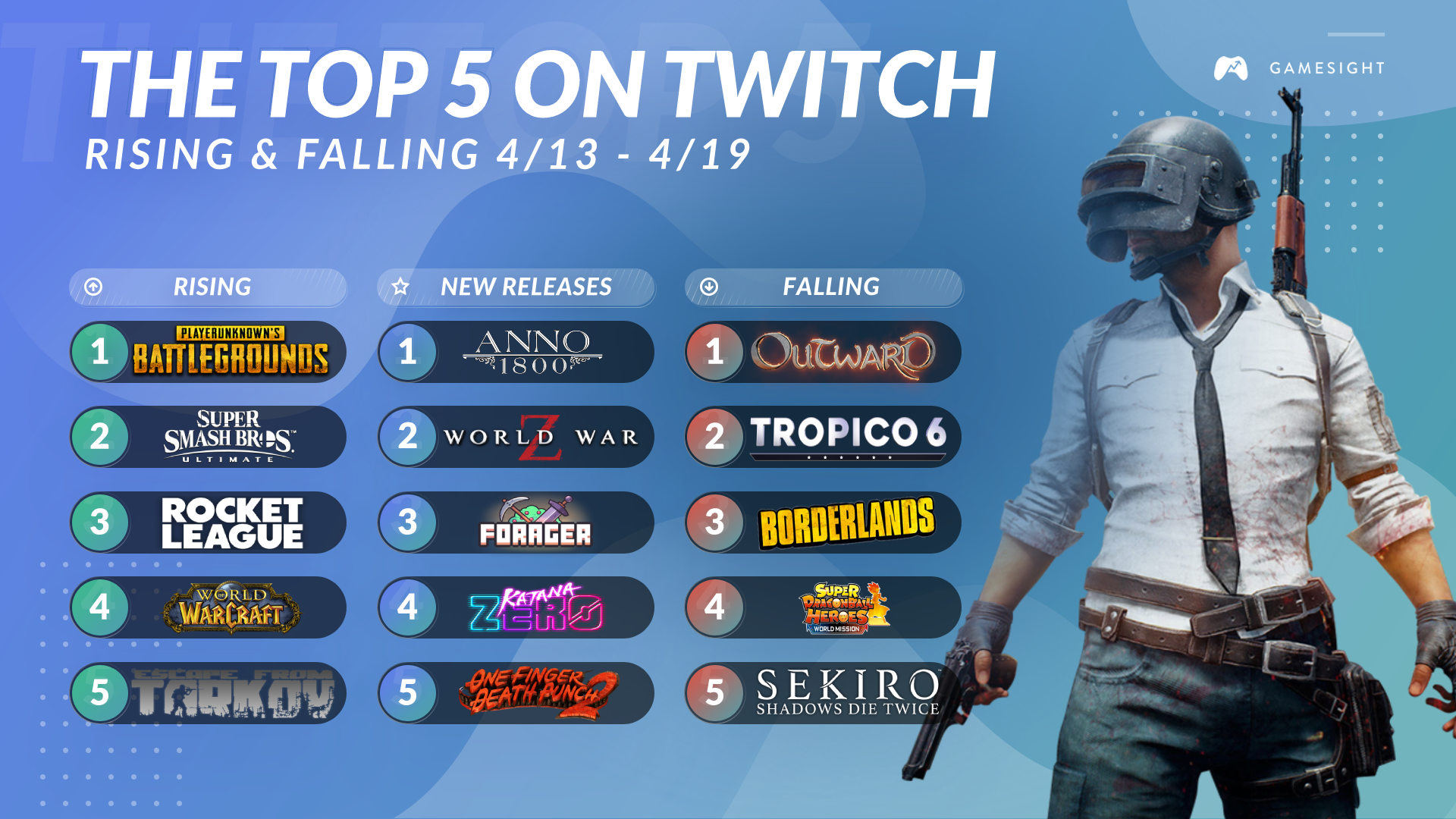Lessons from #Top5OnTwitch: A Big Launch Doesn't Always Last
We analysed ten weeks of our #Top5OnTwitch rankings to see what conclusions we could draw. What we found surprised us.

We analysed ten weeks of our #Top5OnTwitch rankings to see what conclusions we could draw. What we found surprised us.
We’ve been tabulating and releasing our weekly #Top5OnTwitch rankings for a few months, now. For those who don’t know, instead of simply a list of the games with the highest raw viewership numbers, our rankings focus on relative growth, both in viewership and total broadcasts, so as to better represent which games in the streaming space are showing the greatest change in momentum. We think this better encapsulates which titles are, indeed, the top “rising and falling” on Twitch.
We also quickly realized that new titles needed their own distinct category. These three rankings, top rising, new releases, and falling, give a great snapshot of what’s happening on Twitch. It also, as it so happens, allows us to see some interesting patterns.
One such pattern that anyone following our rankings might have noticed is that a significant portion of games which appear in our “Top New Releases” rankings will, relatively soon thereafter, show up as one of our “Top Falling.” We've noticed this too, and hypothesized that, when looking at all of our rankings together, we would see that pattern repeat often. We wanted to take a look back at the last ten weeks of power rankings and see whether that intuition was accurate, and what conclusions might be drawn. What we found proved very interesting.
Conclusion 1: Trending New Releases Have Short Shelf Lives

We took a look at ten weeks of our rankings, focusing on new releases. In that time, we featured fifty titles. Of those titles, sixteen, or 32%, wound up as one of our top falling titles within three weeks. Twelve titles, or 24% of all ranked new releases, became one of our top downward trending games within only two weeks. On average, these games transitioned from new release to top downward trending title in only 2.17 weeks.
This seems to reinforce our original intuition, that an initial surge or interest and success on Twitch doesn’t always or often lead to a sustained streaming presence. What’s more, the more successful a game was on Twitch in its first week, the more likely it was to later appear in our top falling category. 70.5% of games appearing on both lists were originally ranked as either the first or second fastest rising on Twitch.
This makes a lot of sense; the more viewership and total streams you accrue in that first burst after release, the more you have to lose if you don’t hold your audience’s attention long term. Many of the top new titles which did not later appear in our falling category likely saw similarly pronounced declines, but because their original numbers were relatively small, it wasn’t a large enough relative loss to make the latter rankings. The point isn’t that one third of all top new titles end up falling, it’s that they end up falling the fastest of everything on Twitch.
And these patterns didn’t seem to discriminate between large and small studio titles. Of the seventeen top new releases that eventually appeared as falling games, nine were from large to medium publishers compared to eight from small organizations or indies. It is true that the former were more likely to appear high on either list, but, when it comes to sustainability on Twitch, just how “big” of a game it was didn’t seem to make any difference.
As such, our findings were clear: a successful launch on Twitch does little to ensure a strong, sustainable community of streamers and viewers. Granted, a long-term presence on Twitch isn't always necessary for a game to sell well, which is why many of the titles we feature in our top falling list still enjoyed strong sales and growing communities. But, in a world where everybody wants to be the next big thing in streaming, it's important to know that the real work of achieving that kind of success doesn't really start until the hype of your release wears off.
Conclusion 2: No Substantive Difference Between Single Player and Multiplayer Titles

I don’t think it’s controversial to say that multiplayer games account for the majority of Twitch viewership. The biggest titles on the planet - Fortnite, League of Legends, Grand Theft Auto, Dota 2 - they all leverage player interaction, competition, rewarding gameplay loops, and the fact that every game is a little different to build and maintain their enormous audiences. Single player titles still become big-time hits, but they come and go. Multiplayer games stand the test of time, on Twitch, and the most successful of them remain on top for months, or even years.
We assumed this would be equally true when it comes to the relationship between our lists. When looking at everything in aggregate, it was our hypothesis that multiplayer titles would make up the vast majority of rising new releases, and that it would primarily be the single player games that quickly transition to our falling category. When we took a look at the numbers, however, we were a little surprised at how wrong we were.
Firstly, 44% of our top new releases were single player titles. That already was much closer to half than we were expecting. Additionally, of those titles which did move from the new release list to top falling, 47% were single player. Because these games tend to be more story driven with definitive endings, we assumed that they would lose their momentum more quickly than multiplayer games, but the numbers don’t bear that out. The only piece of information that slightly tips in that direction is that, of all the titles featured in our top falling category, 54%, so the majority, were single player games. This does seem to be a manifestation of the inherently shorter lifespan of such titles, but it also doesn’t seem to have any relationship with the new release category.
Don’t misunderstand: it’s still quite clear that the most successful titles on Twitch are where they are because they’re multiplayer games done right. Even when AAA titles with massive hype trains release and become successful, their peak performance rarely approaches the level of the top contenders. But, when you take the stratospherically successful, culturally dominant games out of the equation, the difference between single and multi player games doesn’t seem nearly as pronounced as one might expect. If you're looking to compete with the likes of Fortnite and League of Legends, you must create a multiplayer experience, but for every other level of success, it appears that a quality single player experience has nearly as good a shot as any multiplayer game. A surprise, to be sure, but a welcome one.
Check out our industry-wide report on the state of the collectible card game genre, available here. Also, be sure to check out this week's #Top5OnTwitch rankings, and to follow us on Twitter and LinkedIn for all the latest blogs, announcements, and game marketing news from the team at GAMESIGHT!

